
When you see this rose in flower, Lady Banks’ Rose may fall easier to your lips than its botanical name, Rosa banksiae. There are several versions available (see the Q & A below), but my favourite is the double yellow form, ‘Lutea’, pictured here.
…it only flowers for about a month, but what a month!
– HOUZZ
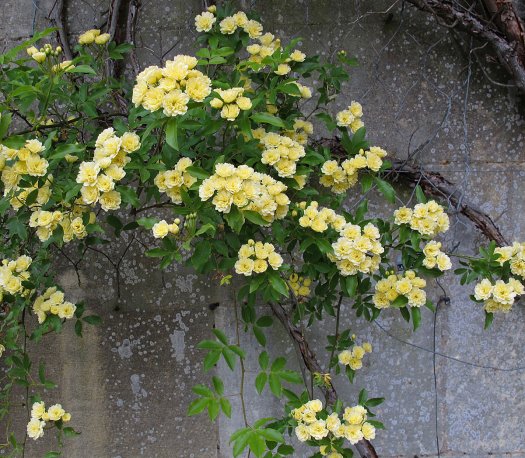
From a distance, a flowering Rosa banksiae ‘Lutea’ is like a pale yellow throw rug; up close, the flowers are small rosettes, held in graceful sprays. If not firmly tied up, the foliage seems to drip on long stems from the plant, creating a distinctive look.
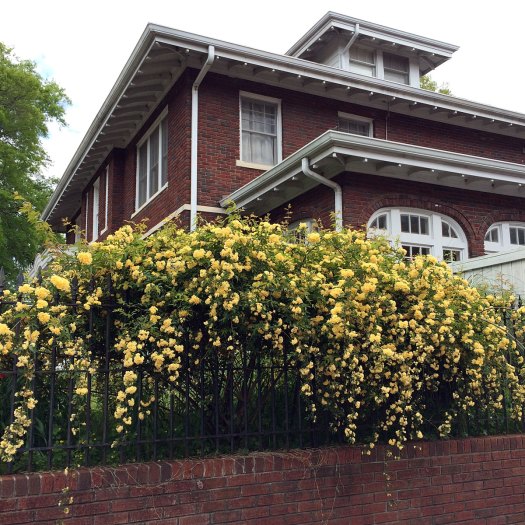
You’ll see online suppliers variously listing this double yellow version, Rosa banksiae ‘Lutea’, as anything from 2m (6ft) in height to 15m (50ft) tall. Prudent gardeners will take 2m with a pinch of salt and assume that 15m refers to a well-established plant, given the support of a large tree and not pruned back. Imagine the width as height moved sideways: it is not unusual to see an old Lady Banks’ Rose 6m (20 ft) wide trained against a wall or fence.
Any Southerner who plants one may be assured that it will outlive his grandchildren.
– The Antique Rose Emporium
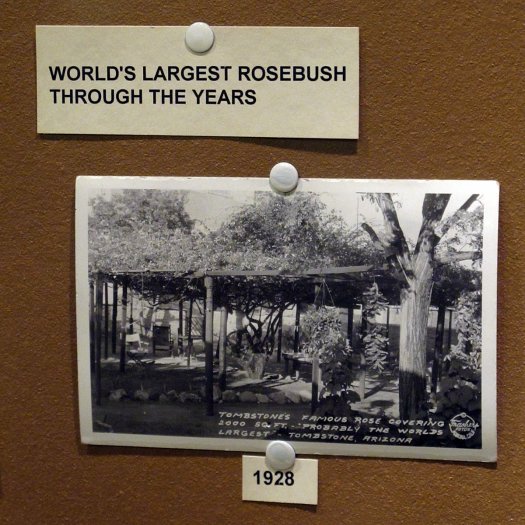
A white form, Rosa banksiae var. banksiae, has been growing over an arbour in Tombstone, Arizona, not far from the O.K. Corall, since 1885. Today it is walled off from tourists who pay to marvel at its girth and stature. The bark of a Rosa banksiae is dark, reddish and slightly peeling, and this particular one looks like a gnarly old tree. The overhead branches are tangled, completely shading the patio below, giving rise to its nickname, the shady lady. We saw it several years ago, sadly, when it was not in flower.
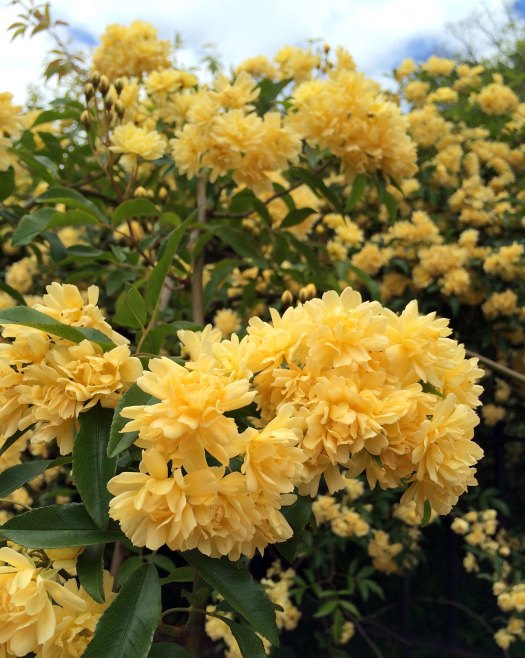
The largest rose reminds me that one of the most important factors to consider when planting (or gifting) a rambling rose is how much space the rose will have to ramble in. If you have to prune the rose severely once or twice each year to keep it in check, you’ll find yourself cutting off thousands of potential blooms and would probably be better off choosing a rose with less ambition. Some of the more mannerly ramblers can be relied on to repeat flower, giving them extra brownie points.
…the plant shouldn’t have survived the first winter here in southeastern Pennsylvania. Good thing I didn’t tell it, as it is now glorious in its fourth spring.
– Star Roses
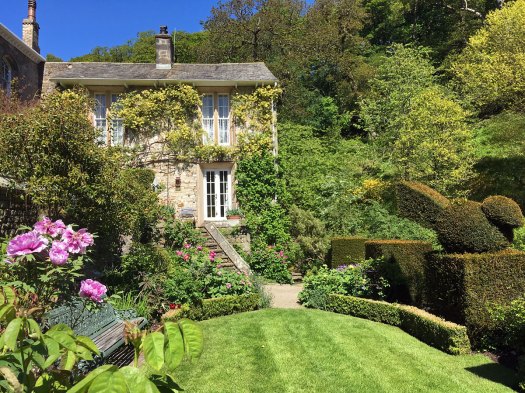
Last weekend, I overheard several people wondering out loud what on earth was the yellow climber on the house wall above, that was doing just fine after a North Lancashire winter. Guesses included a clematis, wisteria, honeysuckle as well as an unknown, exotic vine. When I explained it was a rose, I’m not sure they believed me. Who can blame them? It’s an unusual colour for a rambling rose and it is surprisingly early to flower.
Q & A
What kind of support does Lady Banks’ Rose need?
A good home would be a sheltered house wall, an outhouse, a large expanse of fence, a well-established tree, a series of stone arches, a sturdy trellis, arbour or gazebo. Rosa banksiae can be trained in an espalier shape or left to tumble down a bank. It is possible to keep it pruned as a massive, sprawling shrub although it is rarely grown that way, or as a boundary.
If grown against a tree, start the rose off growing up a ladder positioned several feet away from the base of the trunk that leans back towards the tree. You’ll find it almost impossible to dig close to the trunk, and the rose will have better access to water on the edge of the canopy.
Is it easy to train Lady Banks’ rose?
In some ways Rosa banksiae is easy to train, as the whippy young stems are almost thornless and pliable, so are easy to twist into shape. The rose produces plenty of material to fan out to cover the available space. As with any climbing rose, fanning some of the stems horizontally out to the sides will stimulate more flowering shoots to develop, producing a thicker coverage lower down the plant.
A Rosa banksiae left to its own devices can be a bit of a nightmare to bring back under control simply because of its sheer size and woody growth. Left unchecked for several years, you may end up with a rose with a tree-like base that flowers very high up. I wonder if we have the technology to see Rosa banksiae flowering from space?
How do I prune Lady Banks’ Rose?
Southern Living suggests shaping and tidying the rose in early spring before it flowers. If your plant is large and well established with plenty of flowering growth, that could work well. Other experts, reluctant to sacrifice any bloom, suggest pruning after flowering.
I always think pruning a rose should be less about dancing around a prescribed set of rules and more about individual choice and instinct. If a branch has died or is damaged, cut it out. Otherwise, this is your rose – do whatever you want with it, feeling confident that it will almost certainly bounce back. If you decide it is too big, feel free to chop it back by as much as you like. Too thick? Remove a third or so of the stems, taking them out as low down as you can.
When does Lady Bank’s Rose flower?
One of the earliest roses to flower, expect to see Rosa banksiae ‘Lutea’ smothered in a mass of flower in spring. In Lancashire that usually means late April or early May, depending on the season. Flowers are produced on stems that are at least two or three years old.
In flower, the plant is very distinctive. Tiny, perfectly formed buds appear in clusters, half hidden in the foliage. These rapidly expand into small, primrose yellow, fully double rosettes which all appear at once.
Is the Lady Banks’ Rose scented?
Each flower has only a light, sweet scent of violets but the overall effect can still be pleasant because of the large amount of bloom. A warmer climate tends to accentuate any rose’s fragrance. The custodians of the world’s largest Rosa banksiae claim that when the rose is in flower, its fragrance can be smelled in the neighbouring streets. That must be a great advert!
Can you use Lady Banks’ Rose as a cutting rose?
The flowers and their once-flowering nature makes this about as far away from a typical cutting rose as you can imagine, but the profusion of bloom means a few clusters can be cut without being missed. Rambling roses won’t last long in a posy, but they combine beautifully with other flowers, giving the arrangement a natural quality.
Does Lady Banks’ Rose produce hips?
Some growers say yes, but many gardeners observe that the flowers fall before hips are formed. If you grow the rose, I’d be interested to know if it reliably produces hips.
Is Lady Banks’ Rose evergreen?
In warmer climates, Rosa banksiae is evergreen.
What about winter hardiness…?
None of the banksiae roses are fully hardy, young plants being particularly vulnerable to a winter freeze. Rosa banksiae ‘Lutea’ is reputed to be the hardiest. Give it a sunny, sheltered site and be prepared to try to protect it in winter if your climate is borderline. The Antique Rose Emporium reports that hardiness is questionable below 15 degrees F (-9 C).
… and pests and diseases?
Insects and diseases such as blackspot or mildew rarely prove a significant problem. I have seen the odd Lady Banks’ Rose lightly affected by blackspot, but the vigour of a well-established plant helps it shake an attack off that might harm a less resilient rose.
Some growers report that deer leave Lady Banks’ Rose untouched. Good luck with that!
What types of Rosa banksiae are available?
Rosa banksiae ‘Lutea’ – double yellow flowers; for me, the classic Lady Banks’ Rose.
Rosa banksiae var. banksiae – double white flowers (sometimes listed as ‘Alba Plena’)
Rosa banksiae normalis – single white flowers; the wild rose, native to China.
Rosa banksiae ‘Lutescens’ – single yellow
A double pink rose (Rosa banksiae ‘Rosea’) is sometimes offered for sale – the RHS are listing this as an invalid name. Most likely, it’s a different type of rambler.

We have the white one and the yellow one in our garden in Australia. There are many in our suburb too. I cut large canes when they are in flower and bring them inside for the canaries, who love them. They are very yummy apparently. 🙂
I love that idea. How ever did you think of it? Have you noticed whether your roses make hips?
No rosehips from the banksia rose as we call them here in Australia. Our canaries aren’t caged, so we found out they liked the flowers because they just went and helped themselves to the flowers from the vase. They quite like the taste of ordinary roses too. 🙂 After the long canes are pruned and the laterals cut off, they can be quite useful for gardening projects, like tomato stakes.
I love the image of the canaries treating the vase of flowers as a larder, and you tolerantly accepting their… alternate flower designing, shall we say?
Wow! A vast mansion is required
And a very big ladder.
Wow. That is magnificent. And a little scary.
Yes… don’t try growing it against anything flimsy!
Mine has ambitions to take over the gardening. Pruning it would be a challenge as I am not agile enough to shin up to the top of the tree. But what a sight it is and all this glory from a little cutting 10 years ago,
It’s nice that so many plants are home-rooted. It must give a real sense of achievement to have grown something so impressive from a cutting.
The plants seem perfectly suited to the architecture of the home.
You’re right. It makes me realise what is meant when a rose is described as being formal… though it can look very informal too, if left to its own devices.
Right near the interchange of Highway 1 and Highway 17 in Santa Cruz, there is a huge Lady Banks’ rose that grew up within a grove of redwoods. It is not that it is hugely bulky, but it is very high up there! It climbed into the redwood trees when they were young and had branches to the ground. As the trees grew, and lower branches were pruned away, the rose just grew higher into the canopy, and stayed, and is still up there. The lowest branches of the redwoods are about sixty feet up. The rose is higher than that.
I’d love to see that one. I wonder if that one is the tallest?
It does make me smile (perhaps that should be grimace) to see the plant listed as 2m (6ft) plus by an online supplier. I imagine quite a few gardeners are in for a surprise when they discover its true potential.
Six feet?! Yeah, that seems a bit short. Those without support do not get as tall as those in trees, but they certainly get more than six feet tall. There was a group of them in a massive valley oak surrounded by a motorcourt at an old historic home in San Ramon (or somewhere over there) that was quite grand, and much MUCH larger than the high up one in Santa Cruz, but it obscured what should have been an even more grand valley oak. (I would have gotten rid of the rose.) The valley oak, which was very old and very rotten, fell apart and needed to be removed along with the rose. I think that the rose had a lot to do with it. Anyway, the so-called ‘landscaper replaced the oak with a new #15 specimen, and then planted four of the same rose around it. The roses were as big as the new oak. It was lame!